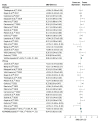Implications of Preoperative Depression for Lumbar Spine Surgery Outcomes: A Systematic Review and Meta-Analysis
- PMID: 38277149
- PMCID: PMC10818221
- DOI: 10.1001/jamanetworkopen.2023.48565
Implications of Preoperative Depression for Lumbar Spine Surgery Outcomes: A Systematic Review and Meta-Analysis
Abstract
Importance: Comorbid depression is common among patients with degenerative lumbar spine disease. Although a well-researched topic, the evidence of the role of depression in spine surgery outcomes remains inconclusive.
Objective: To investigate the association between preoperative depression and patient-reported outcome measures (PROMs) after lumbar spine surgery.
Data sources: A systematic search of PubMed, Cochrane Database of Systematic Reviews, Embase, Scopus, PsychInfo, Web of Science, and ClinicalTrials.gov was performed from database inception to September 14, 2023.
Study selection: Included studies involved adults undergoing lumbar spine surgery and compared PROMs in patients with vs those without depression. Studies evaluating the correlation between preoperative depression and disease severity were also included.
Data extraction and synthesis: All data were independently extracted by 2 authors and independently verified by a third author. Study quality was assessed using Newcastle-Ottawa Scale. Random-effects meta-analysis was used to synthesize data, and I2 was used to assess heterogeneity. Metaregression was performed to identify factors explaining the heterogeneity.
Main outcomes and measures: The primary outcome was the standardized mean difference (SMD) of change from preoperative baseline to postoperative follow-up in PROMs of disability, pain, and physical function for patients with vs without depression. Secondary outcomes were preoperative and postoperative differences in absolute disease severity for these 2 patient populations.
Results: Of the 8459 articles identified, 44 were included in the analysis. These studies involved 21 452 patients with a mean (SD) age of 57 (8) years and included 11 747 females (55%). Among these studies, the median (range) follow-up duration was 12 (6-120) months. The pooled estimates of disability, pain, and physical function showed that patients with depression experienced a greater magnitude of improvement compared with patients without depression, but this difference was not significant (SMD, 0.04 [95% CI, -0.02 to 0.10]; I2 = 75%; P = .21). Nonetheless, patients with depression presented with worse preoperative disease severity in disability, pain, and physical function (SMD, -0.52 [95% CI, -0.62 to -0.41]; I2 = 89%; P < .001), which remained worse postoperatively (SMD, -0.52 [95% CI, -0.75 to -0.28]; I2 = 98%; P < .001). There was no significant correlation between depression severity and the primary outcome. A multivariable metaregression analysis suggested that age, sex (male to female ratio), percentage of comorbidities, and follow-up attrition were significant sources of variance.
Conclusions and relevance: Results of this systematic review and meta-analysis suggested that, although patients with depression had worse disease severity both before and after surgery compared with patients without depression, they had significant potential for recovery in disability, pain, and physical function. Further investigations are needed to examine the association between spine-related disability and depression as well as the role of perioperative mental health treatments.
Conflict of interest statement
Figures




References
-
- Deyo RA, Mirza SK, Martin BI. Back pain prevalence and visit rates: estimates from U.S. national surveys, 2002. Spine (Phila Pa 1976). 2006;31(23):2724-2727. doi:10.1097/01.brs.0000244618.06877.cd - DOI - PubMed
Publication types
MeSH terms
LinkOut - more resources
Full Text Sources
Medical

